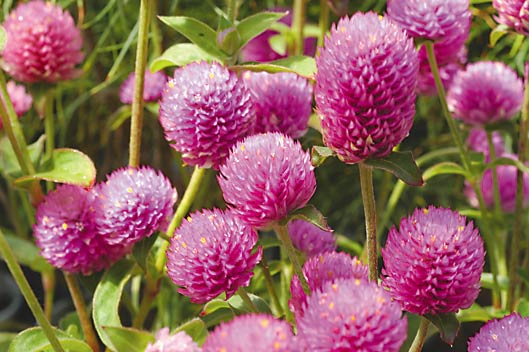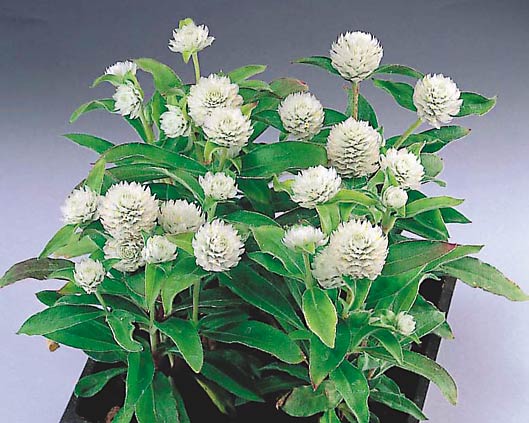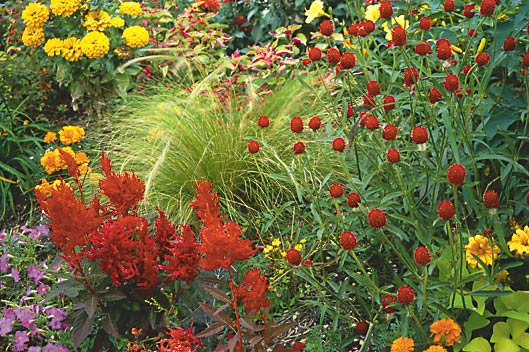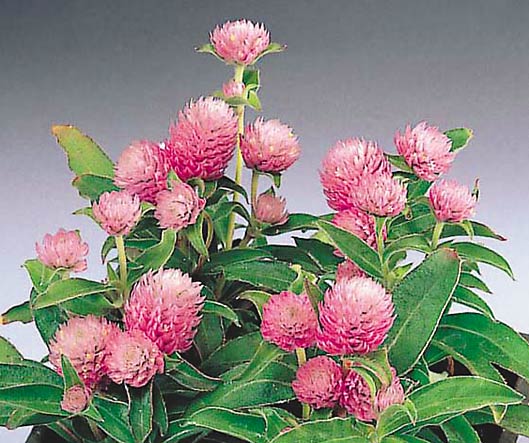 Jonathon Hofley / Michigan Gardener
Jonathon Hofley / Michigan Gardener
‘QIS Lilac’by George Papadelis
The dog days of summer can certainly take a toll on the garden. Many plants are well-suited for intense heat while others struggle to maintain a flower for more than a few hours. One of the most heat-tolerant, and underused, annuals is Gomphrena. Its common name is globe amaranth and it is native to Central America. Once established in the garden, globe amaranth will tolerate temperatures in the hundreds about as well as any annual. It comes in several colors and plant height can vary from just 9 inches tall to over two feet. In my opinion, the best thing about globe amaranth is that it is relatively uncommon; plants will usually draw enough attention to conjure the occasional, “What is that?” I love hearing those words of wonderment from gardeners.
Gomphrena develops clover-like, round flower spikes that are almost 1 inch across. They make a great cut flower, and when dried, they will retain their shape and color indefinitely. They will thrive in any sunny position and will tolerate a broad range of soil as long as it is well-drained. Rain can make some annuals, like petunias, droop and flop. Gomphrena, however, stands strong and erect despite high winds or rain.
 Sakata Seed America
Sakata Seed America
‘Gnome White’The most popular series of gomphrena is the Gnome series. It is a dwarf variety that comes in about four colors including purple, pink, and white. It only grows about 9 inches tall and wide, and makes a great edging plant. In the annual border, this is a more interesting alternative to the common marigold or ageratum. It can also be a valuable addition to containers—especially those exposed to intense sun. Its compact size makes it suitable for sale in small packs just like other, more common bedding plants. It is also one of the more inexpensive annuals you can buy.
The taller gomphrenas are the ones that I find most interesting. They can be used as a unique addition to the perennial border since they are unfamiliar to many gardeners. One of my most pleasant memories of gomphrena came to me at Longwood Gardens. The variety ‘Bicolor Rose’ was planted in a vibrant mass along with several other unique annuals. It stands about two feet tall and the rose-colored flowers sport a spot of white at the tip. This is by far one of the most vividly-colored gomphrenas available. Try this variety in small groups in the perennial garden.
 Julia Hofley
Julia Hofley
‘Strawberry Fields’ Sakata Seed America
Sakata Seed America
‘Gnome Pink’Other tall varieties include ‘Strawberry Fields,’ with strawberry-red flowers on strong upright stems to about 24 inches. ‘Lavender Lady’ has lavender flowers on 24-inch stems. Both of these varieties are getting harder and harder to find. The ‘Woodcreek’ series (also known as the QIS series) grows 24 to 30 inches tall and comes in seven colors including lavender, pink, orange, red, purple, rose, and white. Seeds for these are somewhat more available, especially amongst the cut and dried flower circles. Plants are sometimes sold in larger packs or small pots.
Whether you garden with perennials or annuals, gomphrena provides an interesting, easy to grow, heat-tolerant choice. Gardeners often overlook gomphrena in early spring when garden center plants can appear somewhat unimpressive. But once summer comes along, few annuals can provide such a unique flower and exceptional weather tolerance.
George Papadelis is the owner of Telly’s Greenhouse in Troy, MI.
At a glance: Globe amaranth
Botanical name: Gomphrena (gom-FREE-nuh)
Plant type: Annual
Plant size: 9 to 24 inches tall and wide
Habit: Upright clump
Flower color: Lavender, rose, red, pink, orange, purple, white
Flower size: 1 inch across
Bloom period: Summer
Light: Sun
Soil: Well-drained
Uses: Shorter varieties can be used as edging plants. Taller varieties can be used both in mass annual plantings or in perennial borders.
Remarks: Exceptional heat tolerance. Stands up to wind and rain also. Excellent cut flower; when dried, retains shape and color indefinitely.
